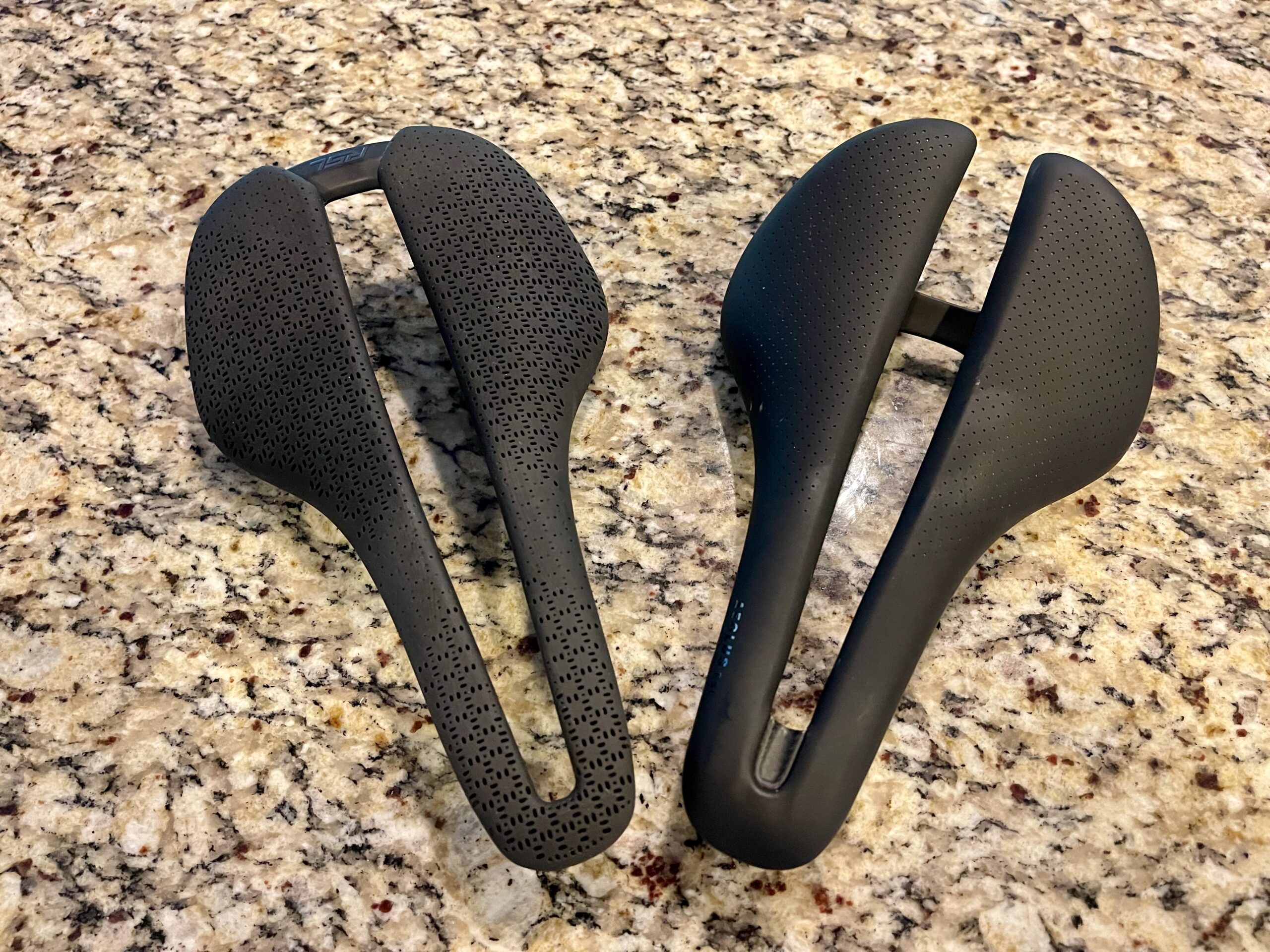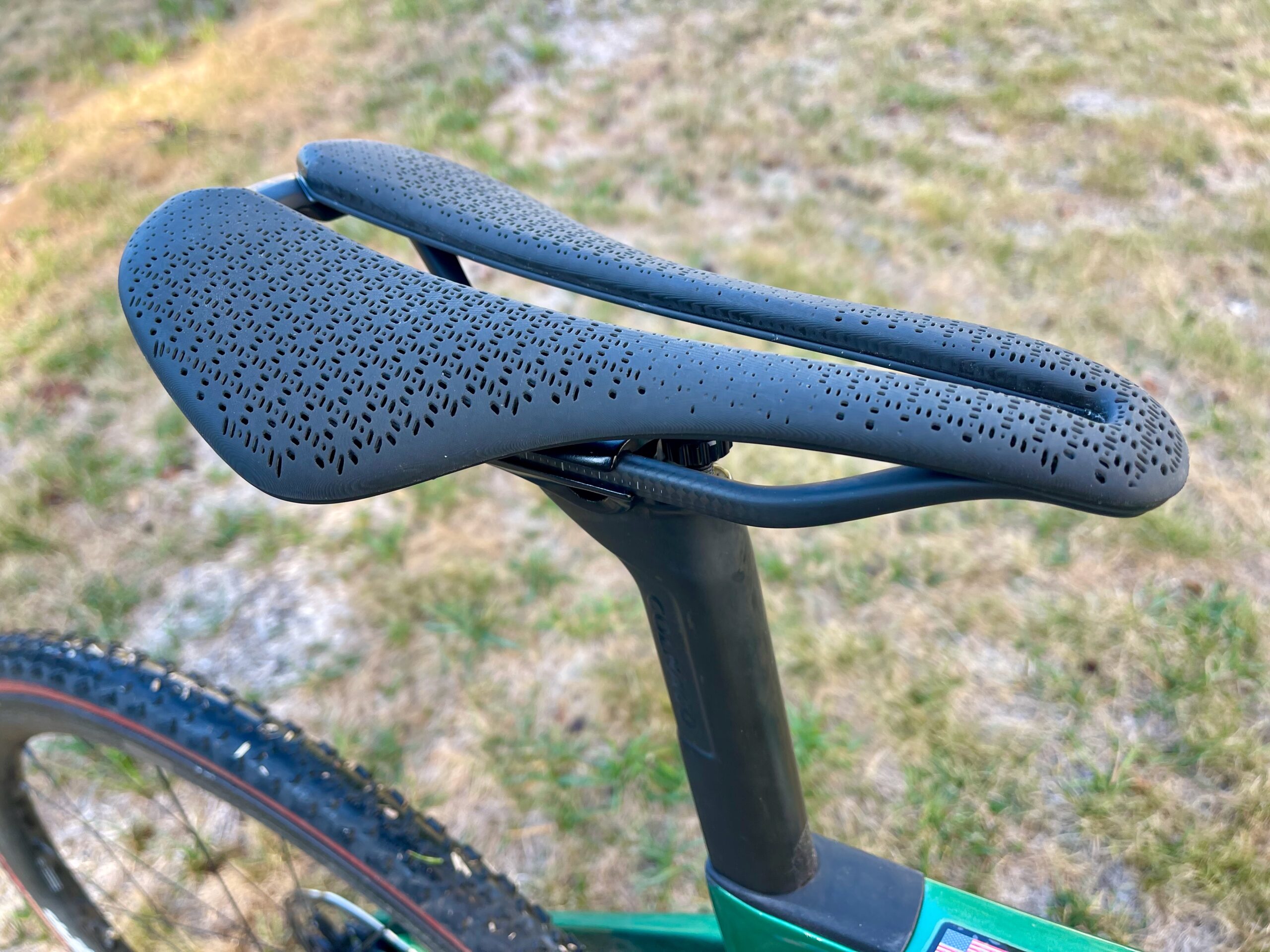Trek has just released its first 3D printed saddle, and it was worth the wait. The new design comes as an update to Trek’s aero-all-around Aeolus saddle range, now featuring AirLoom lattice technology. The new AirLoom (pretty cool name) is a 3D-printed structure designed to provide targeted sit-bone support and pressure relief under soft tissue.
Already tested at the WorldTour and in mountain bike World Cups, the Aeolus AirLoom saddle lineup aims to balance pro-level performance with comfort that holds up over long rides and strenuous efforts. The design is a departure from older 3D printed designs and looks more like the S-Works Power we reviewed earlier this summer. However, some key differences could make the Trek Aeolus a bigger hit.

What is it? Trek Aeolus AirLoom
The new Aeolus AirLoom saddle is Trek’s latest evolution of the short-nose Aeolus platform, now equipped with 3D-printed comfort. The star of the show is the AirLoom lattice, a 3D-printed, truncated-octahedron structure that replaces traditional foam. Unlike foam, which compresses unevenly and loses performance over time, the lattice flexes and rebounds consistently, distributing pressure across sit bones while keeping the perineal channel open and free from hotspots. The result is a saddle that better adapts to rider movement and remains supportive over long hours (more on that later)

The updated Aeolus shape plays a similarly significant role. Trek reworked the transition between nose and wings, narrowing the nose to reduce thigh rub, and added a longer slope that supports riders who rotate forward in an aggressive, aero tuck. Oddly enough, Specialized opted to add some width to the new 3D printed Power saddle (reviewed here), making these two (S-Works vs. Aeolus RSL AirLoom) options even harder to choose from. That is, until you hear the price of both, however.

These refinements were made with feedback from WorldTour pros and MTB racers, where saddle comfort directly translates into performance.
Trek Aeolus AirLoom Models & Pricing
Underneath, each saddle gets a different rail and shell pairing depending on the model:
- Aeolus RSL AirLoom – $424.99, OCLV Carbon shell, oversized carbon rails, 166g (145mm).
- Aeolus Pro AirLoom – $274.99, featuring carbon rails and a composite shell, weighing 180g.
- Aeolus Elite AirLoom – $174.99, featuring steel rails and a nylon shell, weighing 242g.
- Aeolus Elite (Foam) – $99.99, same new Aeolus profile but with traditional foam and cover, 267g.
Widths range from 135 to 155mm, depending on the model, ensuring fit options for a wide range of riders. Trek also includes a Blendr accessory mount under the shell for clean tail light or radar integration.

The AirLoom foam isn’t just about comfort (though that’s why I like it); it also changes how the saddle breathes and manages moisture. With open cells, the AirLoom surface allows airflow and reduces sweat buildup, something Trek’s in-house testers have already noted during summer road and gravel rides. Trek also claims the lattice maintains its shape longer than foam, so performance stays consistent over seasons of riding.

First Ride Review: Aeolus RSL AirLoom
I logged numerous hours on the flagship Aeolus RSL AirLoom, including some road, mountain, and some intense, race-style efforts. First, I was already a big fan of the Aeolus RSL saddle. It’s made the rounds on lots of my review bikes, and is a lovely design. That said, the switch to the RSL Aeolus AirLoom was a no-brainer.


The first impression? Light, especially for a 3D printed saddle. However, it’s not lighter than its RSL foam brethren. At just 166g, the RSL Aeolus Airfoam is heavier than the original RSL Aeolus, which weighs 150g in the same size. But the real magic is comfort. The lattice structure is very much like a foam “feel”. To the hand (and backside), you don’t feel like you’re sitting on a web of computer printout. You feel like you’re supported with a progressive suspension. It’s similar to my sensations of the S-Works Power. The RSL Aeolus AirLoom doesn’t feel like a traditional 3D-printed saddle, and that’s the best part of it.

What About the Updated Shape?
Compared to the previous Aeolus RSL, the new AirLoom RSL keeps the familiar short-nose silhouette but sharpens the details. The nose is narrower, which immediately cuts down on inner-thigh rub, and the transition into the wings has been smoothed for better weight distribution when you’re shifting positions. Trek also extended the sloped nose section, making it more supportive for riders who rotate forward into an aero position on the hoods or drops. The overall shape still screams “Aeolus,” but the refinements make it feel more modern, racier, and friendlier to aggressive positions than the outgoing model.

On The Bike
Compared to a traditional foam Aeolus, the AirLoom feels more alive—it flexes microscopically (waxing poeticly here) with pedal stroke, keeping friction to a minimum. Throwing myself right into the fire — My first ride on the RSL Aeolus AirLoom was a four-hour gravel ride; I didn’t experience the creeping sitbone pressure that usually appears later. The same went for all my other rides on the AirLoom. It’s a significant enhancement to the RSL Aeolus base, and I don’t think that riders will fight the change.

The pricing structure is aggressive for the top tier of the updated line. This saddle tops out at $425, and though that’s on par with others in the world, it’s still expensive. Yes, the OCLV base and rails are lighter and have a slight flex, but it’s a hard pill to swallow. But – so is being super uncomfortable on your bike. So, the choice is yours, but I would check the line out at a Trek Store and see the ascending enhancements firsthand. If you can’t “feel the difference,” stick with the lower tier.

How About Tilt and Fore Aft?
I set up the review RSL Aeolos AirLoom in the exact position as the RSL OG it replaced. The tilt on my original was set at – 2°, and I kept that after going up and down on some test rides. The AirLoom padding is different in that you don’t sink in like some old 3D printed designs. This design keeps the rider suspended and reacts slightly to pressure changes. It’s very comfy – and I’m sold. It feels planted when rotated forward into an aero tuck and stable when moving around during hard accelerations. Like the first Aeolus saddle, this model feels like a hinge where the rider can get into a nice aero or aggressive position without frontal pain. It acts like a joint, and your bones are planted, not moving to adapt to an aggressive posture.

Final Impressions
The Aeolus AirLoom RSL keeps Trek’s promise of light, extremely comfortable, and race-ready in the RSL line. The broader AirLoom lineup makes that same lattice technology available at multiple price points, ensuring more riders can get the pro-level comfort. If you’re dancing around a new saddle and like short nose designs, this should be on your short list 100%.
